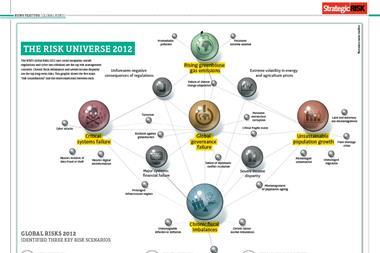When disaster strikes (such as loss of life) should you err on the side of caution (which could be financially punitive) – or should you take less stringent measures and risk regulatory action?
This tricky question of matching safeguards to the actual risks involved is discussed in Global Risks 2012, the seventh edition of the World Economic Forum’s annual risk report released in January. “In defining safeguards, the challenge is to reach the right balance by weighing the consequences of catastrophe and the consequences of stifling an industry’s development,” says the report.
As usual, the WEF takes the macro view. It warns that: “The constellation of risks arising from emerging technologies, financial interdependence, resource depletion and climate change exposes the weak and brittle nature of existing safeguards – the policies, norms, regulations or institutions which serve as a protective system. Our safeguards may no longer be fit to manage vital resources and ensure orderly markets and public safety.”
The report gives two examples where in hindsight regulators’ action appears heavy handed. The first will be very familiar to many European risk managers because of the considerable impact on their own companies’ activities. This was the volcanic ash cloud that spread from Iceland across the skies of Northern Europe. The International Civil Aviation Organization ordered the grounding of thousands of flights according to safeguards developed after the failure of some jet engines in the 1991 Pinatubo Volcanic Eruption.
It is easy to be wise after the event.
Initially, this was widely seen as a sensible precaution due to the lack of clarity on how great a risk the ash would pose to flight safety. However, says the report, “After only a few days, with millions of people and goods left stranded, airlines and airports facing billions of dollars in losses and the Eyjafjallajökull volcano still spewing ash into the sky, the risk of resuming flights began to seem worth taking.” The process of relaxing the regulations began.
It is easy to be wise after the event. However, as the WEF points out, in the absence of safeguards and flights being grounded, if the risk had proved real multiple planes might have suffered engine failure and thousands could have died. Further, this would have destroyed public trust in the safety of flying, with the result that regulators would have defined new standards that were unnecessarily strict.
The second example was Fukushima meltdown following the Japanese earthquake/tsunami last year. This triggered global public anxiety about nuclear power, prompting German politicians to shut down eight of Germany’s 17 nuclear reactors immediately, with the remaining nine to be taken offline by 2022.
The WEF warns that regulations are usually narrowly focused, tailored to specific industries or activities, and aimed to prevent malicious acts, accidents or disasters. “The term ‘safeguards’ is used to broaden the scope of the regulatory debate and promote discussion from a systems perspective. In an environment of increased interdependencies, important ‘secondary’ or ‘spillover’ effects also occur beyond any given initial activity, and these consequences must also be monitored,” says the report. Moreover, regulations themselves can trigger unintended or unforeseen consequences.
The WEF warns that regulations are usually narrowly focused
The common thread linking all the safeguard issues, according to experts, is that decision-makers need to devote more attention and resources to defining the policies, norms, regulations and institutions through which we manage them. While respondents to the WEF survey perceived unforeseen negative consequences of regulation as being a lower-impact risk relative to others, analysis suggests it should be acknowledged as a high-priority “origin” risk, owing to the dense web of links connecting it to other global risks with catastrophic impacts.
The WEF suggests an “anticipatory governance” approach. This implies close, real-time monitoring in the direction in which innovations evolve, and involves defining safeguards flexible enough to be continually tightened or adapted in response to emerging risks and opportunities.
It also promotes the sharing of knowledge and experience so that jurisdictions can learn from each other’s mistakes. “Communication and collaboration are critical in the development of safeguards to ensure that knowledge is captured and shared with the global community,” it says.
Some risk managers – and their boards – may however argue that, while sharing information in this way may be feasible at the macro level, ie where regulators are concerned with major disasters, it may be less easy to achieve in the competitive corporate world. For example, it may not be in a company’s best commercial interests to allow its competitors to learn from its mistakes or, indeed, that it has even made mistakes if these have not reached the public domain.
The WEF concludes that the interdependence and complexity inherent in globalisation require engaging a wider group of stakeholders to establish more adaptable safeguards which could improve effective and timely responses to emerging risks. It suggests that the first step towards a flexible, systemic safeguard approach is awareness-raising and training those responsible for defining safeguards.




















No comments yet